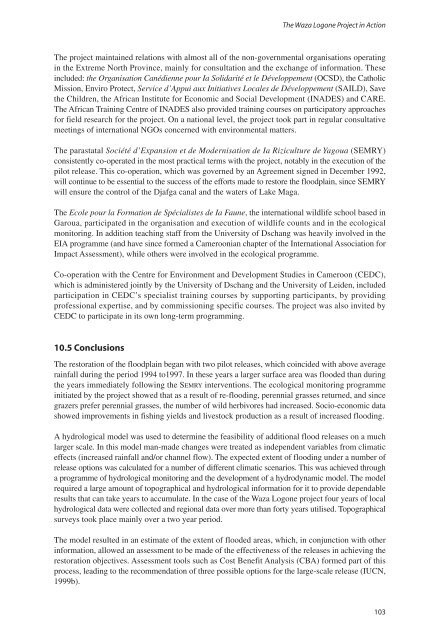The return of the water - IUCN
The return of the water - IUCN
The return of the water - IUCN
You also want an ePaper? Increase the reach of your titles
YUMPU automatically turns print PDFs into web optimized ePapers that Google loves.
<strong>The</strong> project maintained relations with almost all <strong>of</strong> <strong>the</strong> non-governmental organisations operating<br />
in <strong>the</strong> Extreme North Province, mainly for consultation and <strong>the</strong> exchange <strong>of</strong> information. <strong>The</strong>se<br />
included: <strong>the</strong> Organisation Canédienne pour Ia Solidarité et le Développement (OCSD), <strong>the</strong> Catholic<br />
Mission, Enviro Protect, Service d’Appui aux Initiatives Locales de Développement (SAILD), Save<br />
<strong>the</strong> Children, <strong>the</strong> African Institute for Economic and Social Development (INADES) and CARE.<br />
<strong>The</strong> African Training Centre <strong>of</strong> INADES also provided training courses on participatory approaches<br />
for field research for <strong>the</strong> project. On a national level, <strong>the</strong> project took part in regular consultative<br />
meetings <strong>of</strong> international NGOs concerned with environmental matters.<br />
<strong>The</strong> parastatal Société d’Expansion et de Modernisation de Ia Riziculture de Yagoua (SEMRY)<br />
consistently co-operated in <strong>the</strong> most practical terms with <strong>the</strong> project, notably in <strong>the</strong> execution <strong>of</strong> <strong>the</strong><br />
pilot release. This co-operation, which was governed by an Agreement signed in December 1992,<br />
will continue to be essential to <strong>the</strong> success <strong>of</strong> <strong>the</strong> efforts made to restore <strong>the</strong> floodplain, since SEMRY<br />
will ensure <strong>the</strong> control <strong>of</strong> <strong>the</strong> Djafga canal and <strong>the</strong> <strong>water</strong>s <strong>of</strong> Lake Maga.<br />
<strong>The</strong> Ecole pour la Formation de Spécialistes de Ia Faune, <strong>the</strong> international wildlife school based in<br />
Garoua, participated in <strong>the</strong> organisation and execution <strong>of</strong> wildlife counts and in <strong>the</strong> ecological<br />
monitoring. In addition teaching staff from <strong>the</strong> University <strong>of</strong> Dschang was heavily involved in <strong>the</strong><br />
EIA programme (and have since formed a Cameroonian chapter <strong>of</strong> <strong>the</strong> International Association for<br />
Impact Assessment), while o<strong>the</strong>rs were involved in <strong>the</strong> ecological programme.<br />
Co-operation with <strong>the</strong> Centre for Environment and Development Studies in Cameroon (CEDC),<br />
which is administered jointly by <strong>the</strong> University <strong>of</strong> Dschang and <strong>the</strong> University <strong>of</strong> Leiden, included<br />
participation in CEDC’s specialist training courses by supporting participants, by providing<br />
pr<strong>of</strong>essional expertise, and by commissioning specific courses. <strong>The</strong> project was also invited by<br />
CEDC to participate in its own long-term programming.<br />
10.5 Conclusions<br />
<strong>The</strong> Waza Logone Project in Action<br />
<strong>The</strong> restoration <strong>of</strong> <strong>the</strong> floodplain began with two pilot releases, which coincided with above average<br />
rainfall during <strong>the</strong> period 1994 to1997. In <strong>the</strong>se years a larger surface area was flooded than during<br />
<strong>the</strong> years immediately following <strong>the</strong> SEMRY interventions. <strong>The</strong> ecological monitoring programme<br />
initiated by <strong>the</strong> project showed that as a result <strong>of</strong> re-flooding, perennial grasses <strong>return</strong>ed, and since<br />
grazers prefer perennial grasses, <strong>the</strong> number <strong>of</strong> wild herbivores had increased. Socio-economic data<br />
showed improvements in fishing yields and livestock production as a result <strong>of</strong> increased flooding.<br />
A hydrological model was used to determine <strong>the</strong> feasibility <strong>of</strong> additional flood releases on a much<br />
larger scale. In this model man-made changes were treated as independent variables from climatic<br />
effects (increased rainfall and/or channel flow). <strong>The</strong> expected extent <strong>of</strong> flooding under a number <strong>of</strong><br />
release options was calculated for a number <strong>of</strong> different climatic scenarios. This was achieved through<br />
a programme <strong>of</strong> hydrological monitoring and <strong>the</strong> development <strong>of</strong> a hydrodynamic model. <strong>The</strong> model<br />
required a large amount <strong>of</strong> topographical and hydrological information for it to provide dependable<br />
results that can take years to accumulate. In <strong>the</strong> case <strong>of</strong> <strong>the</strong> Waza Logone project four years <strong>of</strong> local<br />
hydrological data were collected and regional data over more than forty years utilised. Topographical<br />
surveys took place mainly over a two year period.<br />
<strong>The</strong> model resulted in an estimate <strong>of</strong> <strong>the</strong> extent <strong>of</strong> flooded areas, which, in conjunction with o<strong>the</strong>r<br />
information, allowed an assessment to be made <strong>of</strong> <strong>the</strong> effectiveness <strong>of</strong> <strong>the</strong> releases in achieving <strong>the</strong><br />
restoration objectives. Assessment tools such as Cost Benefit Analysis (CBA) formed part <strong>of</strong> this<br />
process, leading to <strong>the</strong> recommendation <strong>of</strong> three possible options for <strong>the</strong> large-scale release (<strong>IUCN</strong>,<br />
1999b).<br />
103












